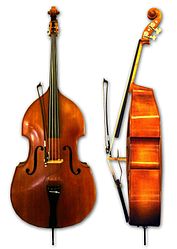Our website is made possible by displaying online advertisements to our visitors.
Please consider supporting us by disabling your ad blocker.
Double bass
This article needs additional citations for verification. (August 2020) |
 Side and front views of a modern double bass with a French-style bow | |
| String instrument | |
|---|---|
| Other names | Bass, upright bass, string bass, acoustic bass, acoustic string bass, contrabass, contrabass viol, bass viol, bass violin, standup bass, bull fiddle, doghouse bass, and bass fiddle |
| Classification | String instrument (bowed or plucked) |
| Hornbostel–Sachs classification | 321.322-71 (Composite chordophone sounded by a bow) |
| Developed | 15th–19th century |
| Playing range | |
 | |
| Related instruments | |
| Musicians | |
| Sound sample | |
|
| |
The double bass (/ˈdʌbəl beɪs/), also known as the upright bass, the acoustic bass, the bull fiddle, or simply the bass, is the largest and lowest-pitched chordophone[1] in the modern symphony orchestra (excluding rare additions such as the octobass).[2] It has four or five strings, and its construction is in between that of the gamba and the violin family.
The bass is a standard member of the orchestra's string section, along with violins, violas, and cellos,[3] as well as the concert band, and is featured in concertos, solo, and chamber music in Western classical music.[4] The bass is used in a range of other genres, such as jazz, blues, rock and roll, rockabilly, country music, bluegrass, tango, folk music and certain types of film and video game soundtracks.
The instrument's exact lineage is still a matter of some debate, with scholars divided on whether the bass is derived from the viol or the violin family.
Being a transposing instrument, the bass is typically notated one octave higher than tuned to avoid excessive ledger lines below the staff. The double bass is the only modern bowed string instrument that is tuned in fourths[5] (like a bass guitar, viol, or the lowest-sounding four strings of a standard guitar), rather than fifths, with strings usually tuned to E1, A1, D2 and G2.
The double bass is played with a bow (arco), or by plucking the strings (pizzicato), or via a variety of extended techniques. In orchestral repertoire and tango music, both arco and pizzicato are employed. In jazz, blues, and rockabilly, pizzicato is the norm. Classical music and jazz use the natural sound produced acoustically by the instrument, as does traditional bluegrass. In funk, blues, reggae, and related genres, the double bass is often amplified.
- ^ Slatford, Rodney; Shipton, Alyn (2001). "Double bass". Oxford Music Online: Grove Music Online. doi:10.1093/gmo/9781561592630.article.46437. ISBN 978-1-56159-263-0. Retrieved 6 December 2019.
- ^ "Ludwig-van.com – The Octobass Is An Instrument Capable of Playing Below Human Hearing Range". 20 May 2015.
- ^ The Orchestra: A User's Manual Archived 29 December 2011 at the Wayback Machine, Andrew Hugill with the Philharmonia Orchestra
- ^ Alfred Planyavsky, "Chamber music in the Vienna Double Bass Archive" Archived 25 August 2021 at the Wayback Machine, September 1996, translated by James Barket
- ^ "Bass basics". Archived from the original on 30 January 2020. Retrieved 30 January 2020.
Previous Page Next Page


